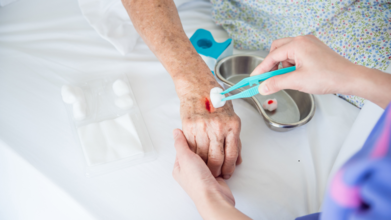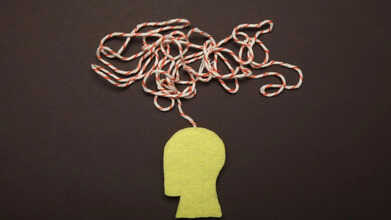- Health Conditions A-Z
- Health & Wellness
- Nutrition
- Fitness
- Health News
- Ayurveda
- Videos
- Medicine A-Z
- Parenting
- Web Stories
What Kind Of Wipes Should You Use To Clean Wounds? Here's What UKHSA Suggests

Credits: Canva
Have you ever gotten a cut or a wound and wondered how to clean it? You may use wipes, but which ones are safe to use? Should you use regular wet wipes? Should you use cotton pads dipped in water or ointment? What is the right way to clean wound?
The UK Health Security Agency (UKHSA) and the Medicines and Healthcare products Regulatory Agency (MHRA) have advised the pubic to stop using certain non-sterile alcohol-free wipes and to dispose of them.
This has come against the backdrop of an investigation for Burkholderia stabilis outbreak. The investigation found that certain wipes were contaminated with Burkholderia stabilis.
The following products have been found affected:
- ValueAid Alcohol Free Cleansing Wipes
- Microsafe Moist Wipe Alcohol Free
- Steroplast Sterowipe Alcohol Free Cleansing Wipes
Public health officials in the UK are urging people to check their first aid kits after certain alcohol-free cleansing wipes were found to be contaminated with a strain of Burkholderia stabilis. Although the contaminated strain identified in Reliwipe Alcohol Free Cleansing Wipes is not the same as that linked to recent outbreak cases, the products have been withdrawn from sale as a precaution.
The wipes may have been used for skin cleansing or cleaning around wounds and could still be found in homes or first aid kits, despite no longer being on sale. These products are not routinely used within the NHS. People are advised not to use the wipes listed in the official recall notice and to dispose of them in household waste.
Do Not Use Non-Sterile Wipes on Broken Skin
Officials stress that non-sterile alcohol-free wipes should never be used to clean wounds, broken skin, or intravenous (IV) lines, as they are not safe for these purposes. Instead, the public should follow NHS guidance for treating cuts and grazes and only use wipes clearly marked as “sterile” for cleaning areas where the skin is broken or bleeding.
Patients with IV lines are advised to follow the care instructions provided by their medical teams. Those who have cystic fibrosis or manage IV lines at home should speak to their healthcare providers if they have concerns about their health or infection risks.
Symptoms to Watch For
Anyone who has used non-sterile, alcohol-free wipes does not need to seek medical care unless they develop symptoms of infection, such as:
Wound infection: redness, swelling, warmth, increased pain, or pus/drainage from the site
Infection involving an IV line: redness, swelling, or pain at the insertion site, along with fever or chills
Official Safety Advice
The UKHSA offers the following guidance for safe wipe use:
- Use only sterile wipes on broken skin, wounds, or scratches to reduce the risk of germs entering the body.
- Check that your first aid kit contains only wipes labelled “sterile,” ensure the packaging is intact, and dispose of any out-of-date or damaged products.
- Only use wipes on IV lines if specifically instructed by your healthcare team.
What Is Burkholderia Stabilis?
The UKSA notes, Burkholderia stabilis is a bacteria found in natural environments. While it rarely causes infection in healthy individuals, it can pose serious risks to people with weakened immune systems, such as those with cystic fibrosis or patients with IV lines.
From 2018 to 2025, there have been 51 confirmed cases of Burkholderia stabilis infection in the UK, now suspected to be linked to some non-sterile alcohol-free wipes. Although no deaths have occurred, some patients required hospital treatment for serious infections. No person-to-person spread has been detected.
Coordinated Public Health Response
UKHSA, the MHRA, and the NHS have been working together to address the outbreak. The MHRA has worked with manufacturers and distributors to stop the sale and supply of affected products. A safety alert has been issued to healthcare professionals, reminding them to follow infection prevention and control guidelines.
Dr James Elston, Consultant in Epidemiology and Public Health at UKHSA, said, “While the overall risk to the public remains very low, a number of non-sterile alcohol-free wipe products have been linked to an outbreak of Burkholderia stabilis. It is important these types of wipes are not used for the treatment of injuries, wounds, or broken skin, and that they are not used to clean intravenous lines.”
He added that testing of patient-used wipes helped identify the source, leading to a swift national safety alert.
Regulatory Action
Dr Alison Cave, MHRA Chief Safety Officer, emphasized that wipes intended for medical purposes are classed as medicines. These products do not have the necessary medicines authorisation, and steps are being taken to enforce compliance.
“If you have these wipes at home or in a first aid kit, check the label and only use wipes marked as ‘sterile’ on broken skin,” Dr Cave advised. “Healthcare professionals should follow instructions provided in the national patient safety alert.”
Anyone who has used alcohol-free wipes and is concerned about possible infection should speak to a healthcare professional.
World Polio Day: How the Polio Vaccine Became a Lifesaving Shield Against a Global Disease

Credits: Canva
In the 1970s, India faced nearly 200,000 polio cases each year. This was not unusual, before vaccines became widespread, diseases we now rarely think about, like polio, caused unnecessary death and immense suffering. Measles, for instance, claimed an estimated 2.6 million lives annually before its vaccine was introduced in the early 1960s.
To ensure every child benefits from vaccines and is protected from preventable diseases, we must learn from successful campaigns, including the global effort to eradicate polio.
Since the global push to eliminate polio began in 1988, cases have dropped by 99.9%. India was officially declared polio-free on March 27, 2014, by the World Health Organization (WHO), following the last reported case of wild polio on January 13, 2011, and a subsequent three-year period without any new cases.
This marked one of the most formidable milestones in public health: India—and the entire South-East Asia Region was certified polio-free, despite limited resources and enormous challenges. On World Polio Day, we take a closer look at how the polio vaccine helped the world stop a global threat.
What is Polio?
Poliomyelitis, or polio, is a viral disease that in its early stages can cause fatigue, headaches, stiffness, and limb pain after exposure to the poliovirus, according to the World Health Organization (WHO). About one in 200 infections leads to paralysis, and 5–10% of those paralyzed may die if the disease immobilizes their breathing muscles. While polio mainly affects children under five, anyone who is unvaccinated is at risk.
In the 19th and 20th centuries, frequent polio outbreaks made it one of the most feared diseases in the United States. The deadliest outbreak occurred in 1952, claiming more than 3,000 lives, according to US public health data.
Polio Affected Hundreds Of Thousands Of Americans
The United States faced its worst polio outbreak in 1952, with nearly 58,000 cases of paralysis and just over 3,000 deaths. Thanks to widespread vaccination, polio was eliminated in the country by 1979.
Polio Eradication In India
India launched the Pulse Polio Immunization Programme on 2 October 1994, at a time when the country accounted for nearly 60% of all polio cases worldwide. Two decades later, on 27 March 2014, India was officially declared polio-free by the World Health Organization, following the last reported case in Howrah, West Bengal, on 13 January 2011, according to WHO records.
The success of this campaign hinged on ensuring vaccines reached every child, including those in the most remote and vulnerable communities. Strong commitment at all levels, from policymakers and health authorities to frontline workers, partners, and community volunteers ensured that life-saving polio drops were delivered to children wherever they were, whether at home, in school, or while traveling.
About The Polio Vaccine
The first polio vaccine was developed in the early 1950s by Dr. Jonas Salk and approved for use across the United States in 1955. This injectable, inactivated polio vaccine (IPV) is still in use in some countries today.
In the late 1950s and early 1960s, Dr. Albert Sabin developed a second option: the oral polio vaccine (OPV). Introduced into the US immunization schedule in 1961, it was inexpensive and easy to administer, which helped it become the most widely used polio vaccine in national immunization programs around the world. While it’s no longer used in the US, it remains especially effective in developing countries.
The two main types of polio vaccines are:
Inactivated Polio Vaccine (IPV)
- Introduced in the US in 1955
- The only polio vaccine used in the US since 2000
- Given via injection, requiring a trained health worker and sterile equipment
Oral Polio Vaccine (OPV)
- Introduced in the US in 1961
- The most widely used polio vaccine globally
- Administered orally and can be given by trained volunteers
How Polio Vaccine Saved World From A Health Crisis
Polio vaccines have played a key role in eliminating the wild form of the disease from many parts of the world, including the Americas, Europe, Southeast Asia, and Africa, according to the World Health Organization (WHO). Czechoslovakia was the first country to show that nationwide eradication of wild poliovirus was possible, achieving this in 1960 after a strong vaccination campaign in which roughly 93% of children received the oral polio vaccine.
Despite these successes, wild poliovirus remains endemic in a few regions, notably Afghanistan and Pakistan.
Hidden Signs of Adult ADHD You Might Be Overlooking, According to Experts

Credits: Canva
A doctor has highlighted the subtle signs he often observes in adults with Attention Deficit Hyperactivity Disorder (ADHD). These are traits people with ADHD may recognise in themselves but that are rarely discussed publicly. A consultant psychiatrist has highlighted subtle signs of Attention Deficit Hyperactivity Disorder (ADHD) that often go unnoticed. Dr. Ali Ajaz, who shares advice with over 97,600 TikTok followers, recently outlined six “hidden features” of ADHD that aren’t as widely discussed as the more familiar symptoms. These lesser-known traits can help adults recognise the condition in themselves or others.
What Is ADHD?
Attention-Deficit/Hyperactivity Disorder (ADHD) is a neurodevelopmental condition that begins in childhood and often continues into adulthood. It involves persistent challenges with attention, hyperactivity, and impulsive behaviour. Children with ADHD may struggle in school, face difficulties in relationships, and experience low self-esteem.
While symptoms can lessen over time, many continue to experience them as adults. Although there’s no cure, early diagnosis and a combination of medication, behavioural therapy, and education can significantly improve daily functioning and long-term outcomes.
ADHD Symptoms
The main symptoms of Attention-Deficit/Hyperactivity Disorder (ADHD) include difficulty focusing, impulsive behaviour, and excessive activity levels. Signs of the condition usually appear before the age of 12 and, in some cases, can be noticed as early as age 3. The symptoms can range from mild to severe and must be present in more than one environment, such as home, school, or work to confirm a diagnosis. These behaviours often interfere with growth, learning, and everyday functioning and may persist into adulthood.
ADHD is diagnosed more frequently in boys than in girls, though it can look different between the two. Boys are often more visibly hyperactive, while girls may show quieter patterns of inattention that can easily go unnoticed.
There are three main types of ADHD:
1. Predominantly Inattentive Type:
Individuals mainly struggle with concentration, organisation, and completing tasks. They may appear forgetful or easily distracted
2. Predominantly Hyperactive-Impulsive Type:
This form involves restlessness, excessive movement, and impulsive decisions. The person may act without considering the consequences or have difficulty sitting still.
3. Combined Type:
This type includes a mix of inattentive and hyperactive-impulsive symptoms, meeting the criteria for both categories.
Hidden Signs of Adult ADHD
Dr Ali Ajaz in his recent tiktok video talked about less than the 'classic' signs of the condition.
According to the doctor, people with ADHD often show certain behaviours that are rarely discussed but are quite common. One of them is hyperfocus which is getting so engrossed in something that they completely lose track of time. While this can be an advantage in some situations, it often causes them to ignore other responsibilities or personal needs.
Another sign is having an unusually high or low sex drive. For some, sex serves as a form of stimulation or a way to release tension, while for others, it feels like too much effort and concentration, leading to disinterest.
He also mentioned binge eating, explaining that the ADHD brain constantly seeks stimulation, and food becomes an easy source of instant gratification. Finally, he pointed out rejection sensitivity, where even mild criticism can feel deeply hurtful, often resulting in overthinking and emotional withdrawal.
The doctor went on to explain that low self-esteem and self-doubt are also very common among people with ADHD. These feelings often come from years of struggling with symptoms, either being told they are not trying hard enough or putting in their best effort but still falling short of expectations. Over time, this combination can deeply affect confidence and self-worth.
Lastly, he mentioned chronic gut problems such as bloating, pain, constipation, or diarrhoea. These issues, he said, are closely linked to the gut-brain connection, as ADHD brains often show signs of inflammation. Much of this inflammation, he explained, comes from diet and eating patterns.
This Common Antidepressant May Quietly Raise Your Blood Pressure, Even As It Helps You Lose Weight

Credits: Canva
Antidepressants side effects weight gain: Antidepressants, widely used to manage mental health conditions, can affect weight, heart rate, and blood pressure, though these changes differ depending on the specific drug. Researchers from King’s College London’s Institute of Psychiatry, Psychology & Neuroscience (IoPPN) conducted one of the most extensive reviews to date, comparing the physical effects of 30 antidepressants. The findings, published in The Lancet, draw on data from over 150 clinical trials involving 58,534 participants who took either antidepressants or placebos for eight weeks.
This Common Antidepressant May Quietly Raise Your Blood Pressure
The researchers observed the biggest differences in weight, heart rate, and blood pressure among those taking antidepressants. They said the results, published in The Lancet, are meant to help patients make informed decisions but advised anyone with concerns to consult their doctor.
Researchers examined how these medications affected patients during the first eight weeks of treatment. Some antidepressants led to weight gains of up to 2 kilograms, while others caused changes in heart rate of as much as 21 beats per minute.
What Is Sertraline?
Sertraline, sold under the brand name Zoloft, is a prescription antidepressant medication that belongs to the class of drugs known as selective serotonin reuptake inhibitors (SSRIs). It works by increasing the levels of serotonin, a natural chemical in the brain that helps regulate mood.
Between 2024 and 2025, about 92.6 million antidepressant prescriptions were issued to roughly 8.89 million people in England, according to data from the NHS Business Services Authority (NHSBSA). Among them, sertraline, taken by an estimated 2.9 million patients, was associated with slight weight loss, averaging about 0.76 kilograms, and a small drop in heart rate. However, it also showed a modest rise in both systolic and diastolic blood pressure.
Sertraline Leads To Increased Blood pressure
An increase in blood pressure can raise the risk of stroke, the researchers noted. However, they also pointed out that the study’s main limitation was its short duration, as it only examined the first eight weeks of treatment. They said more research is needed to understand the longer-term effects of these medications.
Dr. Toby Pillinger, lead researcher and consultant psychiatrist at King’s College London, stressed that the findings are not intended to discourage antidepressant use. Instead, they aim to promote personalised treatment and encourage shared decision-making between doctors and patients, empowering individuals to make more informed choices about their care.
Which Antidepressant Should I Opt For?
The most commonly prescribed antidepressants—SSRIs like paroxetine, citalopram, escitalopram, and sertraline, generally showed fewer physical side effects. Professor Andrea Cipriani from the University of Oxford said it is “impossible” to determine how many of the millions taking antidepressants might benefit from a different medication.
He noted that a focus on “generic, cheap medications” has led to 85% of antidepressant prescriptions in the UK being for just three SSRIs: citalopram, sertraline, and fluoxetine.
According to Cipriani, applying the findings from this study could drastically reduce that 85% figure, allowing more patients to access treatments better suited to their needs.
The research team is also developing a free online tool to help doctors and patients make more informed choices about which antidepressant to use.
© 2024 Bennett, Coleman & Company Limited

